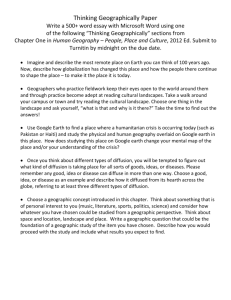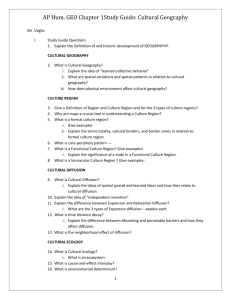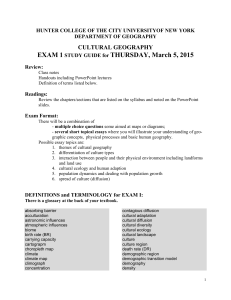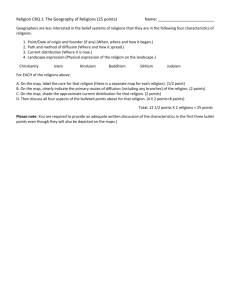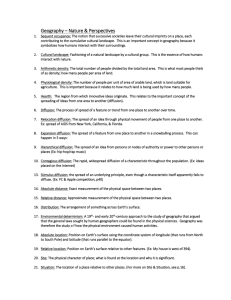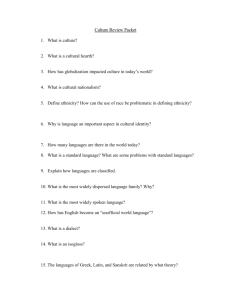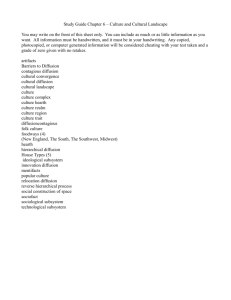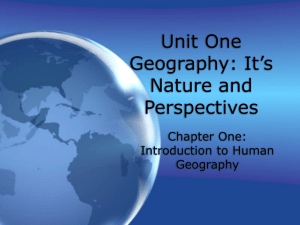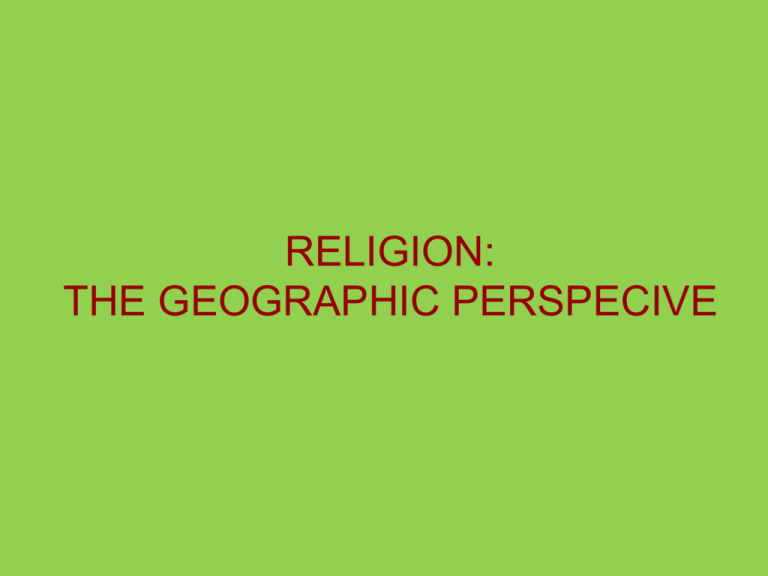
RELIGION:
THE GEOGRAPHIC PERSPECIVE
Hinduism-ethnic religion
Chronologically, the oldest
of the major religions
Arose in Indus Valley,
~4,000 years ago
No evolving
bureaucratic structures
Reincarnation
Doctrines allied with
India's caste system
Tied to the physical
landscape
Modernization and
Gandhi helped relax the
caste system
Ganesh Shrine, Kathmandu, Nepal
Hinduism
Diffusion
Arose in what is now
Pakistan
No modern expansion
diffusion
Area overtaken by
Buddhism and Islam
Bali outpost has
become a syncretic
faith
Relocation diffusion not
the foci
Cultural landscape
Hinduism is a way of
life
Building a temple gives
good Karma…
Shrine location
important
Visual AND emotional
Buddhism- Universalizing
Resurgence in India
Buddha (Prince Siddhartha)
spoke out against caste system
Diffusion
Grew slowly after Buddha’s
death
Fragmented today, but
experiencing a revival
Principals keep diffusing,
notably in the Western world
Cultural landscape
The Bodhi tree
Pagodas
Chinese religions- Ethnic religions
Taoism
Confucianism
Diffusion
Confucianism diffused
early into the Korean
Peninsula, Japan, and
Southeast Asia
Taoism = more local
Chinese communist
authorities leveled burial
mounds because they
took up too much ground
suitable for farming
Cultural landscape
Confucianism and
Taoism help expand
impact of Buddhist
cultural influences
Shinto: ethnic religion of Japan
Judaism-ethnic religion, exception to the rule, has
diffused
The oldest major religion to
emerge west of the Indus Valley
Diffusion
Diaspora
Sephardim
Zionism=homeland for Jewish
people
Israel created in 1948 by UN
Cultural landscape
Synagogues, but no single
architectural style
Star of David appears on most
Jewish graves
The “Wailing Wall”
Wailing Wall, Jerusalem, Israel
Christianity-Universalizing
Jewish search for deliverance from Romans &
appearance of Jesus
Paul’s role
Eastern Roman Empire (Constantinople)
Eastern (Orthodox) Church still one of three major
branches
The papacy, second branch
Protestant movement
Diffusion
A combination of expansion and relocation diffusion
during European colonialism
Most widespread of the global religions
Aggressive and persistent proselytism
http://www.pbs.org/frontlineworld/stories/china_705/
Christianity
Cultural
landscape
Medieval
Europe
Imprint of death
on the
landscape
Uses more
land for
cemeteries
than any other
faith
http://www.mapsofwar.com/ind/history-of-religion.html
Christianity
Religions and culture regions in the United
States
The Mormon culture region
Christian culture regions better known
Islam-universalizing
The youngest of the major faiths
Religious and social disarray in Arab world
Unifying religious faith and set of values
Mecca, Medina, then Jerusalem became the
spiritual center
Believed strongly in education
Still the heart of Arab culture
Islamization
Islam by 900 CE
Islam: Shiite
Regions and sects
Division conflict-2
BRANCHES
Sunnis: family and
community to solve
problems
Shiites: Imam is “solver”
Imams—Shiite Muslims
leaders whose
appointments are regarded
as sanctioned by Allah
Diffusion
Trading expansions led to
conflicts with Christianity
The Crusades
Continues to attract
converts
Experiencing resurgence;
expansion will continue
Classic example of
hierarchical diffusion
Islam
Cultural landscape
Mosques dominate the urban landscapes
Muslim architects very skilled
Exquisite and distinct architecture
A symbol for faith and community
Islam religion and culture are one
The Alhambra
an example of Muslim Architecture
The Dome of the Rock, Jerusalem
an example of Muslim tile glazing
Religious Fundamentalism
A worldwide drive by millions back to the “basics” (in
whose eyes?) of religious faith
Often born out of frustration
“Tunnel Vision”
9/11 led to many American’s equating terrorism with
Islam
Globalization and religions
1. strict adherence to the holy text
2. pious or religiosity
3.
Religious Fundamentalism
Christian fundamentalism
Christian fundamentalism most pronounced in Protestantism
Islamic fundamentalism
Laws not equally applied
Inconsistency breeds dissidence
From Shah to Ayatollah
1970s and 1980s most significant
Afghanistan under the Taliban
Jihad and Wahhabi
Extreme Islamic fundamentalists who resort to violence
are relatively small in number (Usually from the Shiites)
Resources
De Blij, Harm, J. (2007). Human Geography People, Place and Culture.
Hoboken, NJ: John Wiley & Sons Inc.
Domosh, Mona, Neumann, Roderic, Price, Patricia, & Jordan-Bychkov,
2010. The Human Mosaic, A Cultural Approach to Human Geography. New
York: W.H. Freeman and Company.
Fellman, Jerome, D., Getis, Arthur, & Getis, Judith, 2008. Human
Geography, Landscapes of Human Activities. Boston, MA: McGraw-Hill
Higher Education.
Pulsipher, Lydia Mihelic and Alex M. and Pulsipher, 2008. World
Regional Geography, Global Patterns, Local Lives. W.H. Freeman and
Company New York.
Rubenstein, James M. (2008). An introduction to human geography The
cultural landscape. Upper Saddle River, NJ: Pearson Prentice Hall.
Benewick, Robert, & Donald, Stephanie H. (2005). The State of
China Atlas. Berkeley: University of California Press.


